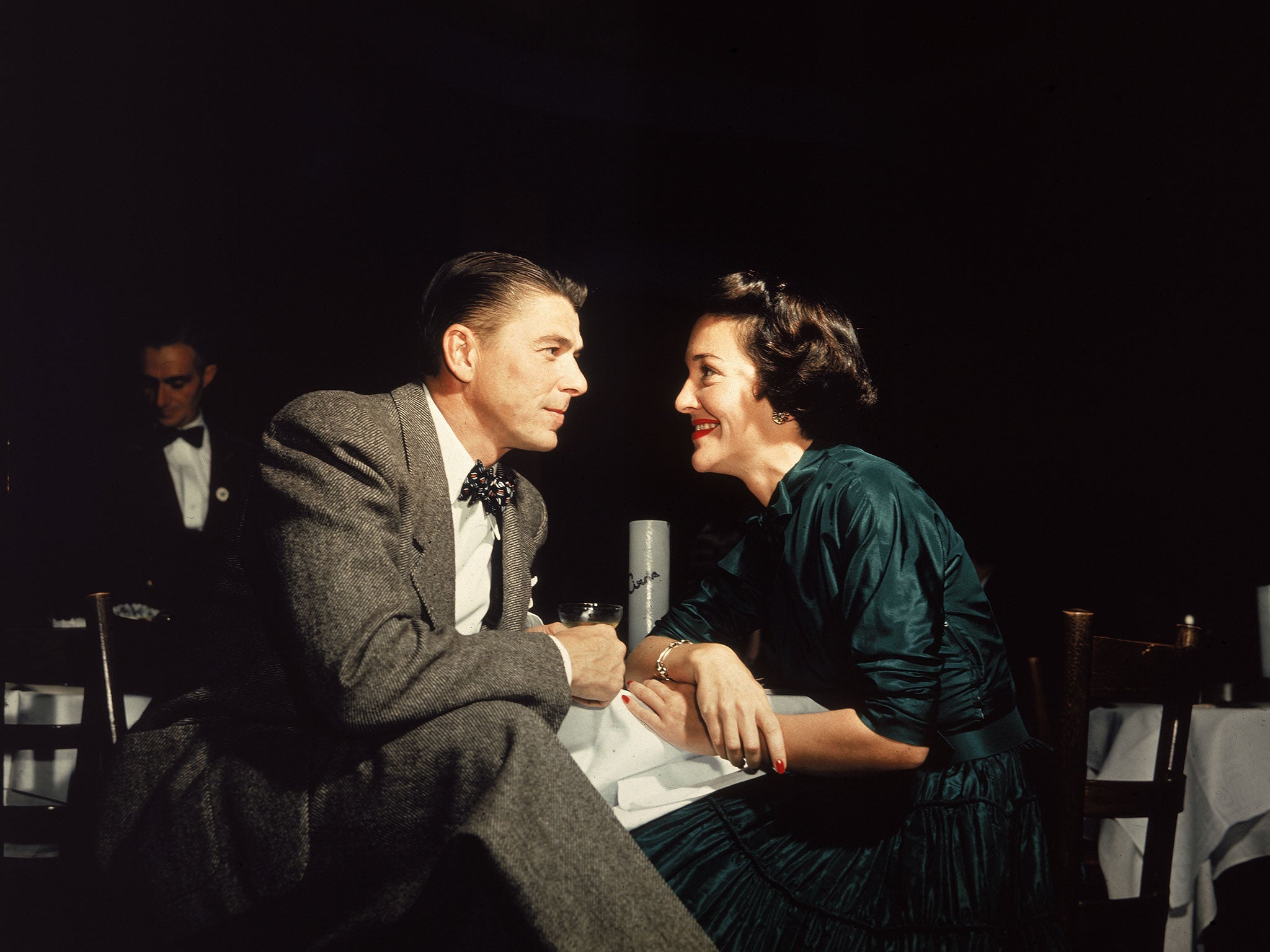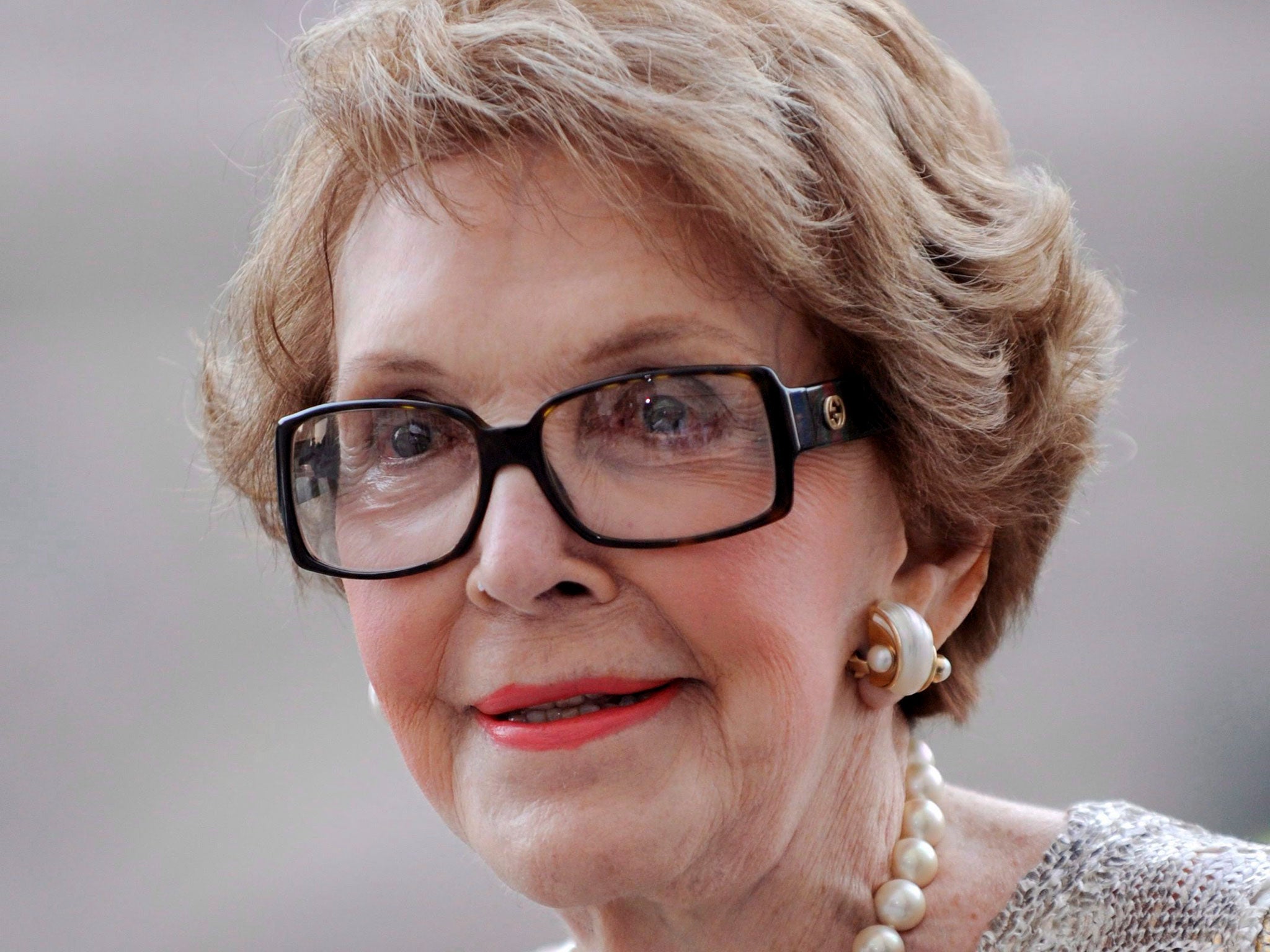Nancy Reagan: Former actress who helped shape Ronald Reagan’s presidency
Mrs Reagan’s style were those of an earlier age by the time she and her husband reached the White House

Nancy Reagan, who died on 5 March, the wife of the 40th President of the United States, was the first former actress to inhabit the White House as First Lady, and she brought to that much scrutinised mansion the authentic whiff of the manipulated glamour of Hollywood. Utterly devoted to her husband, she infuriated his staff and political Washington by her interference, not least when it was dictated by her belief in astrology. But she sustained her husband at all times, especially after his near-assassination in March 1981; and her influence was often wisely used. It is generally agreed that President Reagan’s crowning claim on the world’s gratitude, his successful search for peaceful relations with the disintegrating Soviet Union, owed much to Mrs Reagan’s determination that he should be seen as a man of peace.
Mrs Reagan was born Anne Frances Robbins in 1921. Her mother, Edith Luckett, was an actress. Her marriage to Kenneth Robbins broke up almost immediately, and Nancy was brought up by her aunt and uncle in Bethesda, a suburb of Washington DC, while her mother toured. In 1929 Edith Luckett married the very successful and very conservative neurosurgeon, Dr Loyal Davis, a pillar of the American Medical Association’s campaigns against “socialised medicine”, and the couple moved to a large apartment on Lake Shore Drive in Chicago’s Gold Coast. In her memoirs, Nancy Davis, as she became after she took her stepfather’s name, recalls how before she was 10 she had lived in three very different environments: “as a baby, going from theatre to theatre with my mother; then living a small-town life with my aunt and uncle in Bethesda, and finally in the socially prominent world of Loyal Davis in Chicago”.
Nancy received an excellent education at Chicago Girls’ Latin School and Smith College, where she majored in English and played the lead in a college play. After graduation she acted in summer stock theatre and in 1946 moved to New York. Although her mother never achieved great renown in the theatre, she had played with many well-known actors. She was close to Alla Nazimova, whose circle was both political radical and notably sexually liberated. Indeed, long after her marriage to the conservative and ultra-respectable Dr Davis, Mrs Reagan’s mother retained an unstuffy personality with a taste for risqué jokes which she came to share with her son-in-law. But her friends also included such well-known Hollywood characters as Spencer Tracy. So when Nancy Davis went to seek her fortune as an actress, it was in a walk-up apartment – but in the smartest corner of the East Side; she was dated by Clark Gable; and Mary Martin put her into a Broadway show.
The decisive event of her life took place, however, not in Manhattan but in Hollywood. She acted in a dozen or so movies, receiving star billing above the title in her second movie, Dore Schary’s The Next Voice You Hear. If her social connections and her suitability, with her big eyes and healthy-looking appearance, for “nice girl” roles, made her something more than just another of the many starlets of the day, she never really achieved star status.
One day in 1949, at the height of the paranoia about communism in Hollywood, she was horrified to see her name on one of the lists of communist sympathisers which circulated at the time. It wasn’t really her name, but that of another actress called Nancy Davis. But it could have destroyed a young actress’s career, not to mention shocking an adored stepfather who was so vehemently anti-communist. A friend urged her to consult Ronald Reagan, then president of the Actors Guild, the actors’ trades union. He asked her out to dinner to talk the problem over.
They had both started the evening by saying they had an early call, a standard Hollywood insurance against being bored on a blind date. Instead, after dinner at LaRue’s they went on to Ciro’s and it was almost three in the morning when Ronald Reagan brought his union member home. They had dinner again the next night, and the next. But Reagan was shy of marriage at first. He had been divorced by Jane Wyman some time before, and was in no hurry to risk being hurt again. And he had been consoling himself, as an eligible Hollywood bachelor may do, in the company of some of the prettiest women in the film world.
Nevertheless, a little over two years later, in March 1952, they were married at the Little Brown Church in the Valley, then the “in” place for Hollywood weddings. The marriage remained to the end an unclouded success. Indeed Mrs Reagan once said, à propos of her difficulties with her children and stepchildren, “what I wanted most in the world was to be a good wife and mother. As things turned out, I guess I’ve been more successful at the first than at the second.”

Reagan already had two children by his first marriage, Maureen, who has had a political career in California, and Michael. His and Nancy’s first child, a daughter, Patti, was born in October 1952. (“Go ahead and count,” she commented in her memoirs.) Patti Reagan’s relationship with her mother has been stormy. Her son, Ronald Jnr, found it difficult to adjust to being the son, first of the Governor of California, then of the President. He shocked his parents, first by deciding to take up a career in ballet, where he worked with the well-known Joffrey company in New York, then by living with the young woman he subsequently married. Mrs Reagan had been similarly shocked when her daughter, now Patti Davis, also openly lived with a young man. Mrs Reagan’s relations with her daughter, however, never recovered as those with her son did. She found it impossible to forgive Patti for writing what she referred to as a “terrible book” about the family.
In the White House, as one of her husband’s biographers has put it, Mrs Reagan “subtly altered the standards for combining the worlds of politics and entertainment”’. From the moment of the Inaugural celebrations, Washington was half-shocked, half-impressed by the impact of Hollywood clothes, Hollywood money and Hollywood values. At first, Mrs Reagan was much criticised: for spending $240,000 on china for the White House, on allowing her and her husband’s rich friends to give them expensive presents, for her insensitivity to criticism. Once when the White House counsel sought an appointment to remind her of the restrictions on the acceptance of gifts by officials and their family, she expressed her contempt for such restraints by receiving him in her dressing gown. Many journalists raised their eyebrows publicly at her friendships with the Hollywood party crowd, with wealthy New York figures like Mrs Betsy Bloomingdale, whose husband Alfred had been involved in scandal, or with Frank Sinatra, whose lifestyle and alleged connections with the world of organised crime had even made him persona non grata in the Kennedy White House, but whom Mrs Reagan idolised.
Mrs Reagan’s friends pointed, in her defence, to her work for charity and against drug abuse: “Just say no!” They accused her critics of being motivated by political prejudice or mere envy. She found an excellent way to rout those who inferred that she was too interested in haute couture and glitz generally at the 1984 Gridiron dinner, a Washington occasion at which journalists normally satirise the great in a timid fashion. Mrs Reagan pluckily appeared on the stage and hoofed her way through a number called “Secondhand clothes”, a parody of the old standard “Secondhand Rose”, in self-mockery.
It was a little harder to shrug off the revelation that Mrs Reagan had for years systematically consulted astrologers to discover the most propitious timing for her husband’s actions and appearances. Donald Regan, the White House chief of staff in the second Reagan Administration, did not get on with Mrs Reagan. After he had finally been forced out, in part by pressure from her, he revealed that he had been obliged, when scheduling presidential appearances, to consult a calendar marked with green, red and yellow days, according to the astrological predictions of Mrs Reagan’s “friend” in San Francisco as to whether given days would be good, bad or “iffy”. She even, it appears, delayed surgery on her husband because of the astrological influences of the day.
Mrs Reagan’s style, and in particular her conception of the role of a woman as first and foremost a wife and mother, were those of an earlier age by the time she and her husband reached the White House. As a result she received a good deal of personal criticism and mockery, some of it unfair as well as extremely wounding. She was relieved when she and her husband could retire to California, where friends – it is said at her rather explicit prompting – bought them a house in Los Angeles to go with their beloved ranch in the mountains. Before leaving Washington, she endured breast cancer that necessitated a mastectomy, but she remained publicly spirited and in private a loving and devoted wife, and a far more complex person than the stereotype put about by her critics understood.
Nancy Davis Reagan (Anne Frances Robbins) actress and First Lady: born New York City 6 July 1921; married 1952 Ronald Reagan (one daughter, one son); died Los Angeles, 6 March 2016.
Join our commenting forum
Join thought-provoking conversations, follow other Independent readers and see their replies
Comments
Bookmark popover
Removed from bookmarks